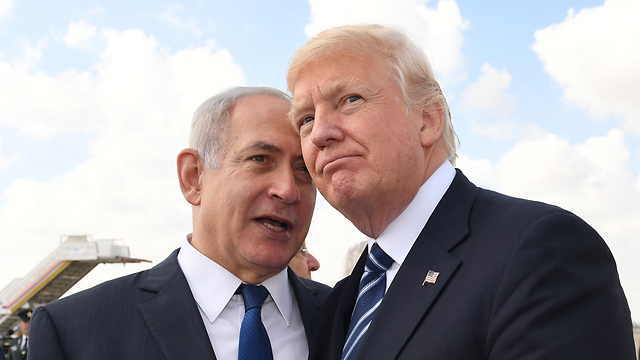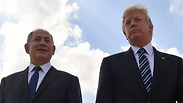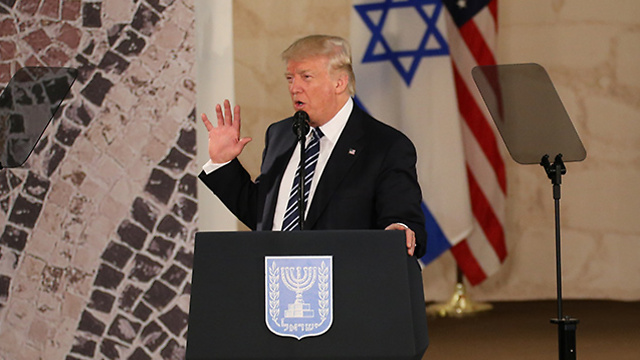
Trump’s message: No Mideast peace without Israeli concession
Analysis: The US president’s visit to Israel was a sort of preparation for the process to resolve the Israeli-Palestinian conflict. During his Mideast trip, and mainly in Saudi Arabia, Trump learned that solving the conflict is a condition for normalizing relations between the Arab states and Israel.
US President Donald Trump’s visit to Israel was historic in many senses, mostly symbolic. In a practical sense, the non-Israeli part of the Mideast trip was actually the significant part, while the visit to Israel was a sort of preparation—foreplay if you like—for a process of resolving the Israeli-Palestinian conflict, which President Trump plans to launch in the near future.
All these things were noticeable in the American president’s speech at the Israel Museum, shortly before he left the country. This speech included three messages: First of all, Israel is the closest ally the US has in the Middle East. Second, Israel is not the problem but, in many senses, the solution to the Middle East’s problems. And third, under no circumstances does the US intend on treating the parties in the Israeli-Palestinian conflict equally—it explicitly favors the State of Israel.

Another clear message was stated on Tuesday: The US will not allow Iran to obtain a nuclear weapon. That is much more than former President Barack Obama’s formula that “all options are on the table”—while it was clear that that was not the case.
Trump showed that he still won’t let the facts bother him. He said there was a “big, beautiful difference” between his administration and the previous one, and then brought up American military aid for the Iron Dome project and the purchase of F-35 stealth fighters as an example. Unfortunately, both deals were signed and largely initiated by President Obama and his administration, which proves that President Trump sees “fake news” as a legitimate weapon, as long as it is in his hands and not in other people’s hands.
As for the Israeli-Palestinian conflict, Trump avoided publicly laying down the path in which he wants to establish peace between the parties. He only said two things: One, that he had found a firm commitment to the process both in Prime Minister Benjamin Netanyahu and in Palestinian President Mahmoud Abbas; and two, that a change must come from both sides and from the inside.
In other words, Trump said, the parties must make the mutual concessions, and we won’t impose anything on them, although we will definitely help them—perhaps by exerting a little pressure sometimes—reach decisions. Nevertheless, Trump is clearly sticking to the policy adopted by the Obama administration and former Secretary of State John Kerry, who kept saying that the parties must make peace between them, and that the US should not force them into it.
The American president didn’t present any practical or concrete move through which he plans to launch the process of solving the Israeli-Palestinian conflict. He made no announcement on an international summit in the summer, as “inside sources” had predicted, or on the duration of the negotiations, which would be limited—according to those same sources—to 12 or 18 months.
Trump didn’t say anything that would serve as an indication of how he plans to turn the words and the promises into action on the ground, even if this ground is the diplomatic arena. But people who have heard him or received reports on his conversations with Middle East leaders are under the impression that the president is very determined to strike the big, ultimate deal.
Those same people got the impression that the Israeli-Palestinian deal is, at the moment, the main foreign relations legacy Trump plans to leave behind. Like every American president, Trump is already working on his “legacy” on the first year of his term.
So how does this information fit in with the allegedly insignificant things that Trump said in his speech? A possible answer is that Trump has yet to form a real outline, and that his visit to Israel and the Palestinian Authority was aimed at preparing public opinion. We should pay attention to the fact that Trump showered his hosts with as many compliments as they showered him with, likely as a way to soften the sides—foreplay, if you like—ahead of the purposeful action that will follow.
Trump’s target audience: US public opinion
The things Trump didn’t say were actually more meaningful. He didn’t talk about the settlements, neither favorably nor negatively, and he didn’t mention the two-state solution at all. Trump understands that these two issues could get Netanyahu in trouble with the Bayit Yehudi party and with people in the prime minister's own Likud party, and he doesn’t want those people to restrict Netanyahu before he decides with his advisors which path to take.
In short, the Mideast visit’s main purpose was to strengthen Trump’s standing in American public opinion through the deal with the Saudis and through uncompromising sympathy towards the State of Israel and the alliance with the Jewish state.

American public opinion was also his target audience when he repositioned the US as a key player in the Middle East, and when he put himself at the lead of the moderate Sunni coalition—in which Israel is a silent partner—against the Shiite radical axis led by Iran.
All this works in favor of the State of Israel. Netanyahu’s right-wing government, however, probably won’t like the fact Trump learned during his journey to the Middle East, and mainly in the time he spent in Saudi Arabia, that there is no chance of normalizing relations between the Arab states and Israel before the Israeli-Palestinian conflict is solved.
That is why he said in Bethlehem that solving the Israeli-Palestinian conflict is a condition for peace in the Middle East. In other words, Israel is not responsible for the fact that there is no peace in the Middle East, but without an Israeli concession—there will be no peace in the Middle East. And that, if you like, is the whole point according to Donald J. Trump.


















